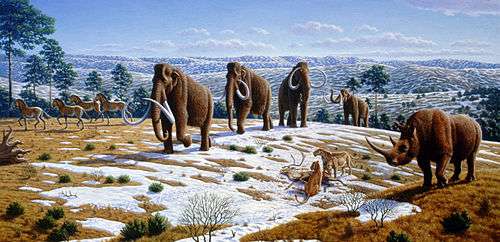Mauricio Antón

Mauricio Antón Ortuzar (born 1961 in Bilbao, Spain) is a paleoartist and illustrator specialized in the scientific reconstruction of extinct life, well known for his influential paintings of hominids, extinct carnivores and other vertebrate fossil groups. His works illustrate a great number of books, scientific papers, private collections and museums in many parts of the world. He currently works in association with the Natural Science Museum [1] in Madrid.
Life and career

Being a teenager in Caracas (Venezuela) in the 1970s, Mauricio became fascinated with the skeleton of the saber-tooth cat Smilodon fatalis on exhibition at the local museum.[2] Ever since, he has been working and improving his techniques to bring fossils alive, being especially interested in felids, hominids and other vertebrates. As he puts it in one of his books (El secreto de los fósiles [3]) “It is the responsibility of the scientific paleo-illustrator to make sure that his images rigorously transmit the knowledge that the paleontologists have gathered from specific extinct species.”
To do this he gathers data from extant species, travelling the world extensively, working hands on fossils, dissecting specimens donated by zoos, researching on extinct species with specialists and using extant ecosystems as a basis for the reconstruction of past ones. He has been an advisor on paleobiology, biomechanics, animal locomotion, and habitats of extinct vertebrates for various media (BBC, National Geographic Society, Natural History, Discovery Channel, etc.). He has benefited from the influences of paleoart masters such as Charles R. Knight, Rudolph Zallinger, Zdenek Burian, Jay Matternes and others from whom he not only recognizes the technological advances but also the conceptual progress they made.
Since the year 2004 he has been working in collaboration with "The Fly Factory" animation studios[4] in the application of 3D modeling and animation to the reconstruction of past life. In 2006 he won the "John Lanzendorf" prize for the best scientific illustration from the SVP (Society of Vertebrate Paleontology).[5] In 2009 he was invited by the Chinese Institute of Vertebrate Paleontology and Paleoanthropology[6] to visit their Beijing Museum and also the new Museum and fossil sites at Hezheng in central China, where he made firsthand observations of undescribed carnivore fossils.
Between 2009-2010 he contributed to the "Extreme Mammals" exposition [7] of the American Museum of Natural History, New York.
In recent years Mauricio is leading art safaris to Northern Botswana under the title "Drawing the Big Cats", sharing first hand sightings and his experience in studying the anatomy and evolution of felids with artists from all around the world.
Publications

Among his most well known books are:
- Sabertooth. Text and illustrations by Mauricio Anton. Indiana University Press, Bloomington 2013.
- La Gran Migración. Jordi Agustí y Mauricio Antón. Crítica, Barcelona, 2011.
- Madrid antes del hombre. Mauricio Antón y Jorge Morales, Coordinadores. Comunidad de Madrid, 2009.
- Dogs, their fossil relatives and evolutionary history. Xiaoming Wang, Richard Tedford and Mauricio Anton. Columbia University Press New York 2008.
- Antón, Mauricio (2007) El secreto de los fósiles. Aguilar.* Turner, Alan y Antón, Mauricio (2004) The National Geographic book of prehistoric mammals. National Geographic. [En español: Larousse de los mamíferos prehistóricos. Spes-Larousse, 2007]* Turner, Alan y Antón, Mauricio (2004) Evolving Eden. An illustrated guide to the evolution of the african large mammal fauna, Columbia University Press.
- Agustí, Jordi y Antón, Mauricio (2002) Mammoths, sabertooths and hominids. 65 million years of mammalian evolution in Europe. Columbia University Press.
- Jordi Agustí y Antón, Mauricio (1997) Memoria de la Tierra. Vertebrados fósiles de la Península Ibérica. Ediciones del Serbal.
- Turner, Alan y Antón, Mauricio (1997) The big cats and their fossil relatives. An illustrated guide to their evolution and natural history. Columbia University Press.
Notes
- ↑ Museo de Ciencias Naturales, Madrid, Spain. http://www.mncn.csic.es/.
- ↑ El secreto de los fósiles. http://www.paleontologia-nautilus.com/bibliografia/secreto.htm.
- ↑ El secreto de los fósiles. http://www.paleontologia-nautilus.com/bibliografia/secreto.htm.
- ↑ The Fly Factory: http://www.theflyfactory.net/
- ↑ John Lanzendorf paleoart prize: http://www.vertpaleo.org/.
- ↑ Chinese Institute of Vertebrate Paleontology http://english.ivpp.cas.cn/au/bi/
- ↑ Extreme Mammals http://www.amnh.org/exhibitions/extrememammals/
External links
- Mauricio Antón official webpage
- Mauricio Antón blog
- Mauricio Antón Facebook
- Drawing the big Cats 2014
- Trailer Sabertooth book in Youtube
- Trailer Bringing sabertooths back in Youtube